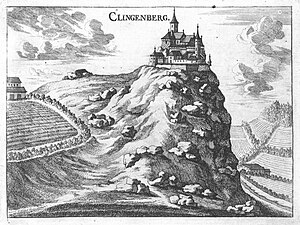Klingenberg castle ruins
| Klingenberg castle ruins | ||
|---|---|---|
|
Klingenberg around 1674, engraving by GMVischer |
||
| Creation time : | 12th Century | |
| Castle type : | Hilltop castle | |
| Conservation status: | ruin | |
| Place: | St. Thomas on the bladder stone | |
| Geographical location | 48 ° 19 '26 " N , 14 ° 47' 19" E | |
| Height: | 672 m above sea level A. | |
|
|
||
The Klingenberg castle ruin is a hilltop castle, presumably built in the 11th century by the Lords of Perg , around 2.3 kilometers northeast of St. Thomas am Blasenstein in the Perg district in the Mühlviertel in Upper Austria .
location
The award given to decay ruin is located on a wooded hilltop in 672 m above sea level. A. about the same distance from St. Thomas am Blasenstein and Pabneukirchen . From the forester's house / Meierhof in Untermaselsdorf, the facility can be reached in about fifteen minutes on a forest path.
description
The castle complex was built entirely from stone blocks at three levels and covered a total area of 3061 m². In the north-west is the highest point of the keep , the southern half of which collapsed in 1855. From the north half of the wall still protrude into the completely wooded ruins. A wall breakthrough allows a view of the Ruttenstein castle ruins from the keep . From the keep to the south-east there were three plateaus descending in height: the hall connected to the keep with a battlement on the outer wall, the first outer bailey from the 15th century with a cistern over 100 m deep, the second bailey with a large one , level courtyard and a gate with a wide late Gothic arched gate. The ruin has been in decline since the 17th century and no conservation measures are currently being taken.
history
Klingenberg Castle was built and inhabited by the noble family of the Perg-Machländer in the 11th century . The complex then came to the family of the Clam-Velburg family , whose last heir, Count Ulrich, did not return from the crusade in 1217, after which Klingenberg passed on to Duke Leopold VI. passed over. In princely Urbar of 1220/40, ownership is listed, which belonged to the rule Klingenberg: 13 fiefdoms and six Hofstätten. Klingenberg initially remained in ducal possession and so came through the Babenbergs and Ottokar Přemysl to the Habsburgs , who pledged the rule with other possessions to the Lords of Walsee , who owned the castle until 1358. The Pfandbrief was redeemed that year by Duke Albrecht II , but the castle was pledged to Hans von Traun a little later . In 1395 Duke Albrecht III. Klingenberg brothers Wenzel and Ernst Preuhafen life-long jointure to keep in exchange for other goods and for the commitment to the castle repaired. The pledge ownership later changed to several noble families: the Rohrbacher (from 1433), then the Neudecker , the Liechtensteiner (until 1490), the Schneckenreuter, and the Prüschenk (from 1491). In 1500 the lien ownership changed to Laßla Prager on Windhaag (County Windhaag near Windhaag near Perg ). The long list of owners continues: in 1524 Klingenberg passed to Achaz von Losenstein , in 1527 to the Steyr citizen Georg Kremser , who was followed in 1536 by Sebastian Kremser .
In 1588 Lorenz Schütter acquired the lordship of Klingenberg including the market and parish Münzbach with the following purchase agreement:
"10. August 1588, Crauiston on the Polish-Russian border: Archduke Maximilian, King of Poland, leaves Lorenz Schütter, Oberdreissiger zu Ungarisch-Altenburg and, for 22 years, his sister the Queen of France and his brother Ernst Diener, who pays the purchase price for the Archduke for the rule of Klingenberg by virtue of the purchase contract with Emperor Rudolf II dated March 11, 1588 in the amount of 12,204 guilders 6 lb. 20 d. On March 19, he paid the Vizedomamt in Vienna out of his own funds, through his chamberlain Hanns Jakob Löbl of Greinburg hereditary answer for free property. Signature of the Archduke "
Klingenberg is also mentioned among the refuge castles chosen in view of the Turkish threat in 1594. In 1630, Klingenberg and the Münzbach market were sold to the Waldhausen Monastery. The monastery withdrew the administration from the castle and left the complex to decay. As a result, Klingenberg was mostly only inhabited by goalkeepers. In 1750, a total of 47 subject houses were named that belonged to the Klingenberg rule. Fire and lightning strikes accelerated the further deterioration of the complex, which was occasionally still inhabited by officials. After the abolition of the Waldhausen monastery by Emperor Joseph II , the rule, the castle and the Meierhof zu Klingenberg as well as the associated forest went to the cathedral chapter Linz , which is still the owner of Klingenberg to this day. In 1855 part of the keep collapsed. Until the 20th century, the castle was still inhabited by poor residents, today Klingenberg is completely in ruins.
See also
literature
- Georg Grüll : Klingenberg. From the story of a Machland castle. In: Mühlviertler Heimatblätter . Volume 2, Linz 1962, issue 1/2, pp. 26–28, online (PDF) in the forum OoeGeschichte.at.
- Herbert Erich Baumert, Georg Grüll: Castles and palaces in Upper Austria. Volume 1: Mühlviertel and Linz. Vienna 1988, pp. 165-169.
Web links
- Entry via Klingenberg to Burgen-Austria
- Klingenberg at Burgenkunde.at
Individual evidence
- ↑ a b c Grüll: Klingenberg. From the story of a Machland castle. 1962, p. 26.
- ^ Document: Waldhausen, former Augustinian Canons (1147–1826) 1588 VIII 10 in the European document archive Monasterium.net .



